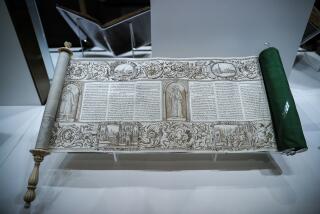FICTION
- Share via
A BOOK THAT WAS LOST and Other Stories by S.Y. Agnon edited by Alan Mintz and Anne Golomb Hoffman (Schocken Books: $27.50; 448 pp.). Most of the stories in this collection, drawn from the lifework of Polish-Israeli Nobel literature laureate S.Y. Agnon, can be read as moral fables. There’s the man who trades his exceptional tefillin (a set of boxes containing scriptures) for a single etrog (a lemon-like fruit needed for Sukkot celebrations); the glutton who hides an enormous fish in his tefillin bag during a fish boycott started and respected by his fellow Jews; the peddler who moves in with a wealthy country woman and for a time lives far above his station, all the while ignoring obvious signs that she’s a vampire. The gloss is plain: such men court disaster in disregarding the dictates of God, man and common sense. Agnon’s stories are more subtle than this superficial reading indicates, however, for they cut in many directions, as may be noted from the fact that the fish story (“Pisces”) turns out to be as much about the netted fish as its would-be eater, that the wandering Jew (“The Lady and the Peddler”) manages to kill the vampire but seems to have learned nothing from the experience.
Agnon’s stories are deeply rooted in the Jewish story-telling tradition, in framework as well as content and tone, but they are also artfully subversive, gently mocking various features of Jewish culture. In “The Tale of the Scribe” Agnon portrays a Torah copier so devoted to his work, so holy and righteous, that his wife dies, childless and chaste, of neglect. The countercurrents found in these deceptively simple stories demonstrate why Shmuel Yosef Czaczkes changed his name to Agnon, a word derived (the editors note in their introduction) from the Jewish term for a woman who cannot remarry because her missing husband never divorced her. Agnon (1888-1970) himself is betwixt and between--European and Israeli, insider and outsider, traditional and modern--and in that sense the editors of “The Book That Was Lost” are right to compare his work to that of Joyce and Faulkner.
More to Read
Sign up for our Book Club newsletter
Get the latest news, events and more from the Los Angeles Times Book Club, and help us get L.A. reading and talking.
You may occasionally receive promotional content from the Los Angeles Times.










